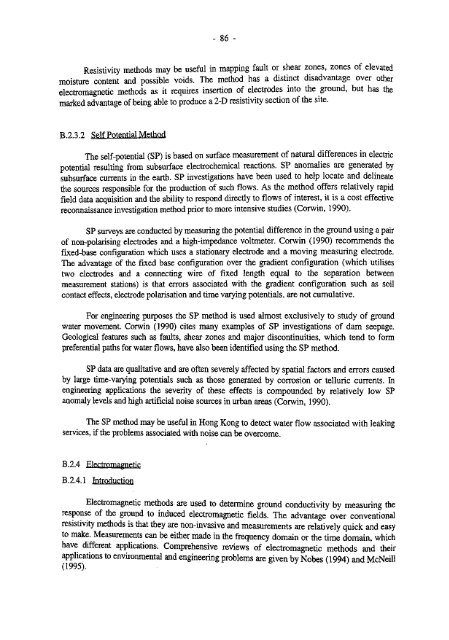site characterisation study - phases 1 and 2 - HKU Libraries - The ...
site characterisation study - phases 1 and 2 - HKU Libraries - The ...
site characterisation study - phases 1 and 2 - HKU Libraries - The ...
- No tags were found...
You also want an ePaper? Increase the reach of your titles
YUMPU automatically turns print PDFs into web optimized ePapers that Google loves.
- 86 -Resistivity methods may be useful in mapping fault or shear zones, zones of elevatedmoisture content <strong>and</strong> possible voids. <strong>The</strong> method has a distinct disadvantage over otherelectromagnetic methods as it requires insertion of electrodes into the ground, but has themarked advantage of being able to produce a 2-D resistivity section of the <strong>site</strong>.B.2.3.2 Self Potential Method<strong>The</strong> self-potential (SP) is based on surface measurement of natural differences in electricpotential resulting from subsurface electrochemical reactions. SP anomalies are generated bysubsurface currents in the earth. SP investigations have been used to help locate <strong>and</strong> delineatethe sources responsible for the production of such flows. As the method offers relatively rapidfield data acquisition <strong>and</strong> the ability to respond directly to flows of interest, it is a cost effectivereconnaissance investigation method prior to more intensive studies (Corwin, 1990).SP surveys are conducted by measuring the potential difference in the ground using a pairof non-polarising electrodes <strong>and</strong> a high-impedance voltmeter. Corwin (1990) recommends thefixed-base configuration which uses a stationary electrode <strong>and</strong> a moving measuring electrode.<strong>The</strong> advantage of the fixed base configuration over the gradient configuration (which utilisestwo electrodes <strong>and</strong> a connecting wire of fixed length equal to the separation betweenmeasurement stations) is that errors associated with the gradient configuration such as soilcontact effects, electrode polarisation <strong>and</strong> time varying potentials, are not cumulative.For engineering purposes the SP method is used almost exclusively to <strong>study</strong> of groundwater movement. Corwin (1990) cites many examples of SP investigations of dam seepage.Geological features such as faults, shear zones <strong>and</strong> major discontinuities, which tend to formpreferential paths for water flows, have also been identified using the SP method.SP data are qualitative <strong>and</strong> are often severely affected by spatial factors <strong>and</strong> errors causedby large time-varying potentials such as those generated by corrosion or telluric currents. Inengineering applications the severity of these effects is compounded by relatively low SPanomaly levels <strong>and</strong> high artificial noise sources in urban areas (Corwin, 1990).<strong>The</strong> SP method may be useful in Hong Kong to detect water flow associated with leakingservices, if the problems associated with noise can be overcome.B.2.4 EleetromagneticB .2.4.1 IntroductionElectromagnetic methods are used to determine ground conductivity by measuring theresponse of the ground to induced electromagnetic fields. <strong>The</strong> advantage over conventionalresistivity methods is that they are non-invasive <strong>and</strong> measurements are relatively quick <strong>and</strong> easyto make. Measurements can be either made in the frequency domain or the time domain, whichhave different applications. Comprehensive reviews of electromagnetic methods <strong>and</strong> theirapplications to environmental <strong>and</strong> engineering problems are given by Nobes (1994) <strong>and</strong> McNeill
















